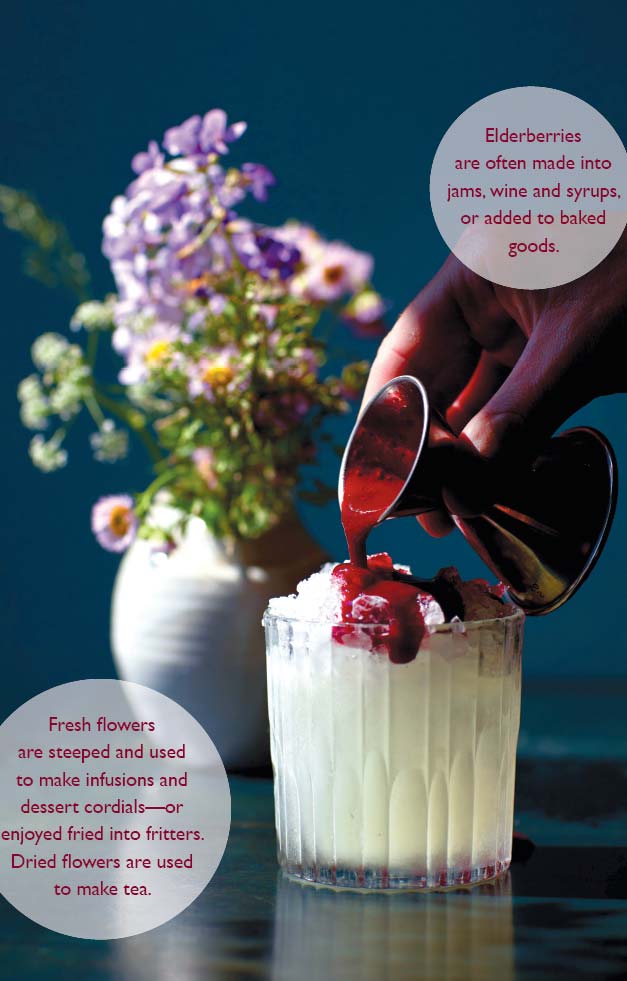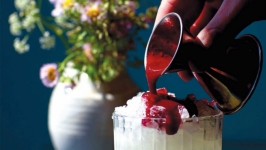Wild Fruit
Elderberries: A Native Berry with Benefits
In the height of summer, you may be lucky enough to spot the boisterous, lacey white flowers of elderberry brightening up the brightening up the seasonal landscape. The flowers have both culinary and medicinal uses, but it’s the berries that receive the most attention—touted for their immune-boosting qualities to combat cold and flu.
There are two types of elderberry (or elder) plants that are typically found growing in our area—one that’s native, and one of European descent.
“Sambucus Canadensis is the native variety and is a stouter plant that ranges from 8 to 10 feet [in height],” says Lindsay Napolitano of Fields Without Fences in Frenchtown. “Sambucus Nigra is the European species, and grows upwards of 12 to 20 feet tall.”
One major difference between the two is that the native variety colonizes and connects underground, creating large groves.
“Native elderberry plants prefer wetter areas and do well at the edges of rivers and stream beds,” she says. “They are used in restoration to stave off soil erosion, and provide habitats for insects and birds—who will often get to the ripe berries before you do.”
Elder is referred to as a “calendar plant,” meaning that it can be an indicator of the change of seasons.
“Right around summer solstice, the elder shrub comes into bloom with beautiful white, upward-facing flowers. By the time the fall equinox rolls around, most of the berries have turned a deep purple and hang downward toward the earth. It traces the seasonality as it unfolds.”
Elderberry has often been used in herbal medicine, particularly to boost the immune system.
“The berries have potent anti-inflammatory and antioxidant effects, and also help prevent viral replication, which can help lessen the duration of colds and flu,” she says. “It’s also great for heart health because its tannic qualities help tone the cardiovascular system.”
While the berry sounds nutritious and delicious, Napolitano heeds that the berries cannot be eaten raw. “On their own they taste horrible—they need to be cooked down and sweetened with honey, sugar or syrup to make them palatable.”
It’s a good thing they taste bad raw, because elderberries actually contain a certain degree of toxicity that is removed during cooking.
“The risk of toxicity comes from a cyanide-containing compound called cyanogenic glycoside sambunigrin, which is found in the bark, root, leaves and the uncooked juice of elderberries,” says Jane Ziegler, DCN, RDN, LDN, of the Rutgers School of Health Professions in Newark, noting that any fruit that’s cooked is safe.
Elderberries contain compounds that work together to aid in overall wellness.
“Elderberries have antioxidants like phytochemicals, flavonoids and vitamin C,” Ziegler says, adding that since humans are not able to synthesize vitamin C in the body, we have to get it in the foods we eat. “Not only is it a powerful antioxidant, it’s essential in the synthesis of collagen. If someone has had surgery, burns or a wound of any type, vitamin C is very important because collagen is necessary for wound healing.” Elderberries are also a good source of potassium, containing 280mg in a 100g serving.
“Potassium is important for cardiovascular health. Most adults have a diet that’s high in sodium and low in potassium. A diet rich in potassium is beneficial for controlling blood pressure,” says Ziegler. “It also helps regulate fluid balance, and is involved in the electrical functions within the body, like muscle contractions.”
While the berries are the most revered part of the plant, the flowers are often cut and harvested for use as well.
“Sambucus canadensis is valued for its berries, and sambucus nigra is valued for the scent of its flowers, which have culinary and medicinal uses,” says Laura Hamill of Perennial Herbal Collective in Lambertville, who uses both the berries and flowers to make herbal tea blends.
“While the fresh flowers are fragrant and used in infusions, the dried flowers, which are lighter in flavor, are used medicinally to stimulate sweating,” she says. “It’s great to steep with your favorite iced tea when it’s hot outside to help keep you cool both internally and externally, and the laciness of the flowers adds a lovely touch.”
So whether you’re combating a cold or hiking in the heat of summer, consider giving elderberries a try—a native plant with a pharmacy of uses.

PHOTOGRAPH: CHRIS GIFFORD, NEW HOPE, PA
“Right around summer solstice, the elder shrub comes into bloom with beautiful white, upward-facing flowers. By the time the fall equinox rolls around, most of the berries have turned a deep purple and hang downward toward the earth. It traces the seasonality as it unfolds.”
—Lindsay Napolitano, Fields Without Fences, Frenchtown






